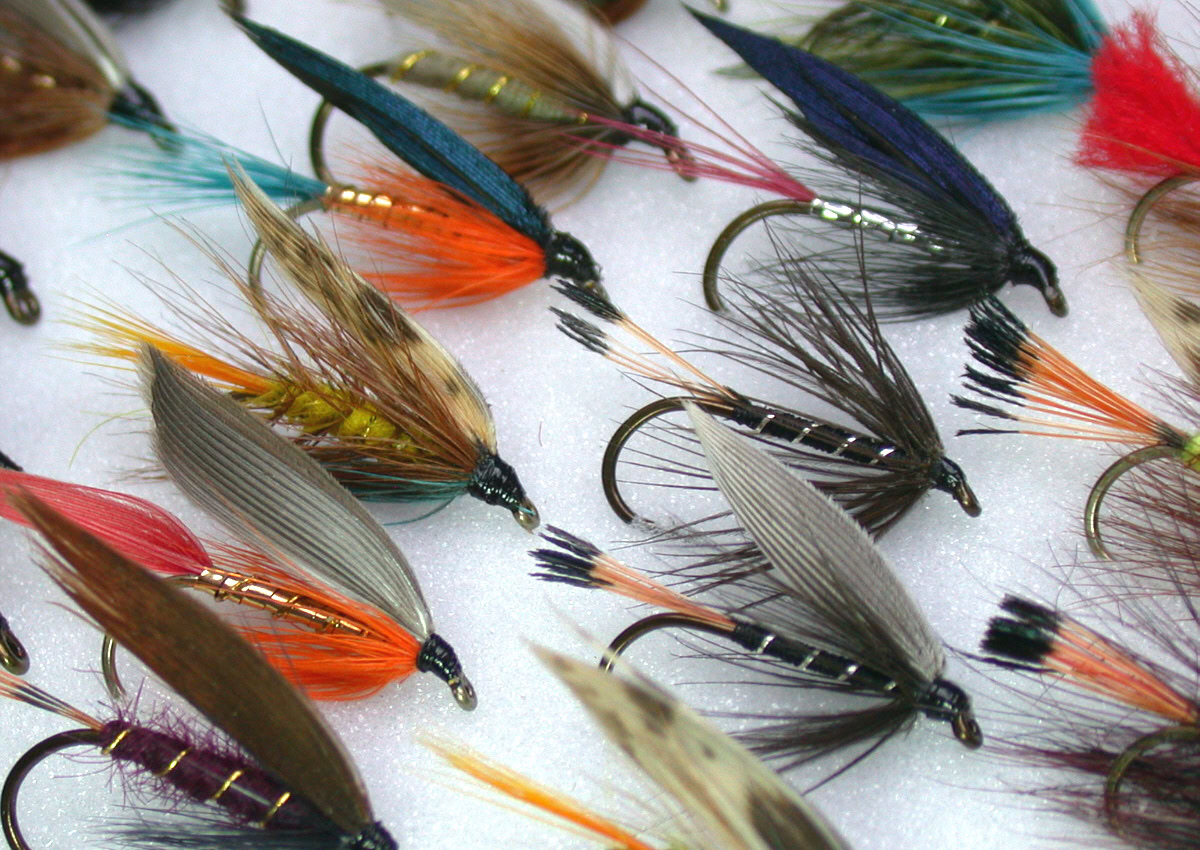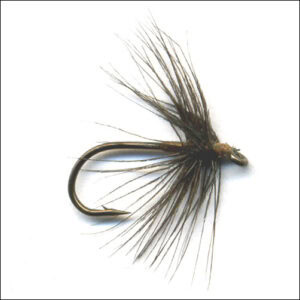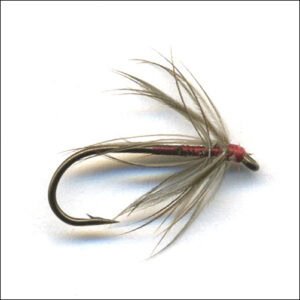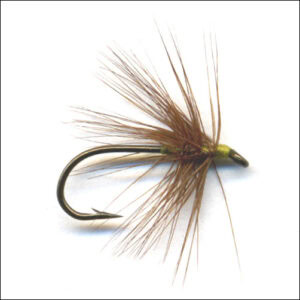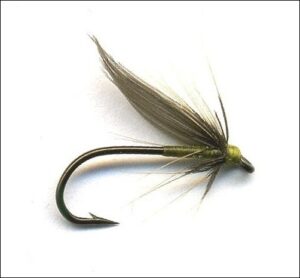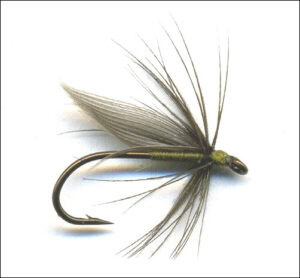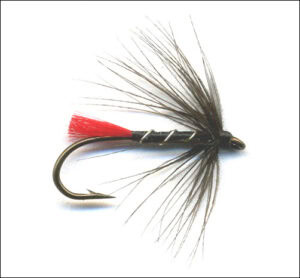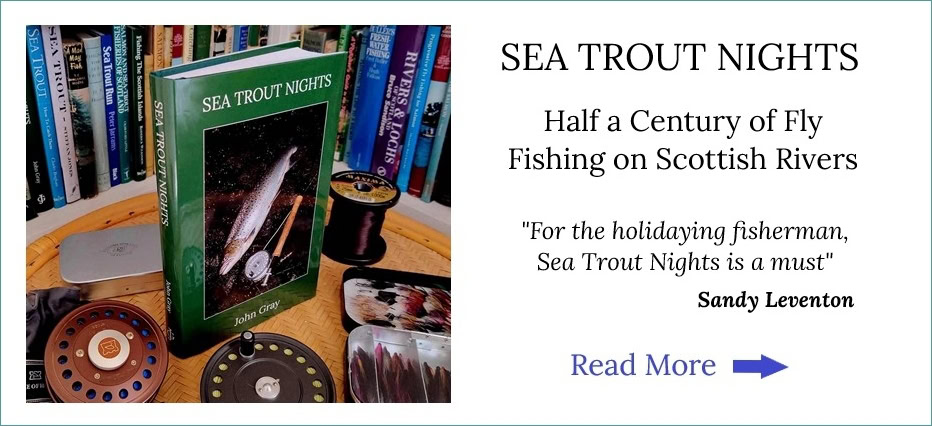The Trout Fishing Fly
The Trout Flies of Scotland
This website will focus on trout flies, primarily for brown trout fly fishing in the UK, in particular on Scottish lochs and rivers; at trout fly tying, featuring examples of renowned traditional Scottish and British fly patterns; something of the history and evolution of the trout fly, focussing on the classic traditional trout flies devised over the centuries for fly fishing on the lochs and rivers of Scotland, many still as popular and effective today as they ever were.
History of the Trout Fly
Angling for fish such as trout with artificial flies dates back to the 2nd century, when the Roman, Caudius Aelianus wrote about the practice of Macedonian anglers on the Astraeus River. The artificial fly used had a red wool body with two wax coloured feathers “which grow under a cock’s wattles” fitted over the wool. This may have resembled a Red Palmer or Soldier Palmer trout fly of today, with the feathers would around the wool body of the fly in palmer fashion, or perhaps the two feathers were paired and tied in as a wing on top of the wool. The fact that two feathers were specified may suggest the latter.
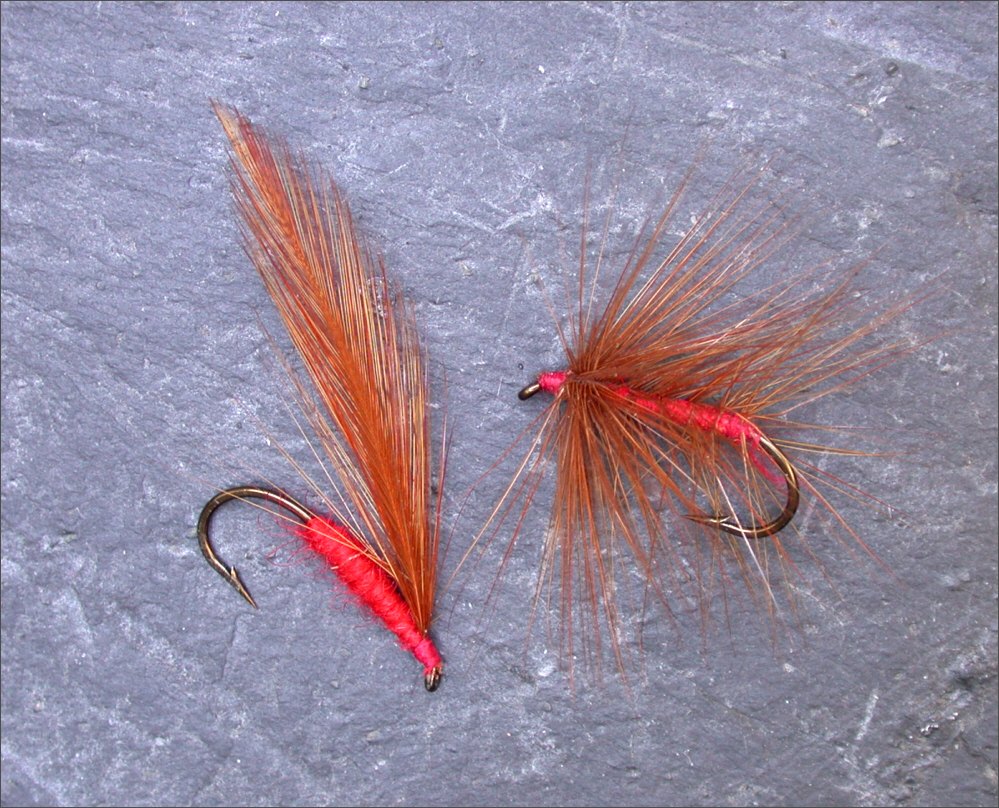
The Macedonian Fly?
“They fasten red wool round a hook and fix on to the wool two feathers that grow under a cock’s wattles and which in colour are like wax”
In Great Britain, little was written on trout flies and fly fishing until the publication in 1496 of The Treatyse on Fysshynge with an Angle, by Dame Juliana Berners. Trout fly fishing grew in popularity through the nineteenth century. Fly fishing clubs were established and books appeared on trout fly tying and trout fly fishing techniques. Since then, fly fishing for trout, and other species, has become an extremely popular and enduring pastime the world over.
In “An Angler’s Entomology”, J. R. Harris wrote in 1952, “Anglers, of all human groups devoted to a hobby or a sport, are perhaps the most strongly obsessed with their occupation and with all that belongs to it. Indeed, the fact that sporting fish feed primarily on insects and can be caught by devices which simulate these insects, has been the basis for a scientific literature and an equally astonishing display of invention in fly tying”. This sums up nicely the essence of trout fly fishing and the preoccupation of the fly fisherman with the artificial fly he offers to his quarry, the trout … and perhaps explains why you are reading this now.
In most, though not all trout fishing situations, fly selection is often crucial to success. As A. Courtney Williams wrote in “A dictionary of Trout Flies”, “To the fly-fisher, the artificial fly must be a vital link in his outfit. The most expensive rod, reel and line will avail him but little if the fly he chooses fails to attract fish”.
Trout Flies – The Early Days in Scotland
That is not to say that precise imitation is necessary, a point well expressed by W. C. Stewart in The Practical Angler as early as 1857. “…. in practice it has been proved beyond doubt that a black, brown, red and dun-coloured fly, used together, and varied in size according to circumstances, will at any time kill as well, and even better, than the most elaborate collection arranged for every month of the year. If trout are at all inclined to rise, one or other of the above will be found inviting. It is quite clear that whatever the angler’s opinion with regard to flies may be – whether he believes that he must have an imitation of some insect on the water at the time, that he must have a fly of the same colour as the majority of those on the water, or with ourselves holds neither of these opinions; if he has four flies such as those mentioned above, he cannot be very far off the mark, as these comprise all the leading colours of which insects generally are.” Stewart promoted the use of simple, sparse yet carefully tied, spider patterns for the most part. He expressed the reasonable view that “The great point, then, in fly-dressing, is to make the artificial fly resemble the natural insect in shape, and the great characteristic of all river insects is extreme lightness and neatness of form”…. and very effective they were too in catching Scottish trout (and English trout, as evidenced by the efficacy of the similar style of North Country Spiders used south of the border), in all probability owing primarily to their simplicity. Examples of the kind of trout flies favoured by Stewart are illustrated below.
Stewart’s Trout Flies
Examples of Stewart’s style of river trout flies
Artificial trout flies used by Clyde anglers were traditionally designed along similar lines, generally sparsely and lightly dressed, both with and without wings, which were generally slim and delicate. We are indebted to John Reid for “Clyde Style Flies” in which he describes in detail the unique style of trout fishing flies, in the main river flies like the Hen Blackie, Grey Hen and Rusty, Mavis and Black, Pope’s Fancy, Sand Fly, White Tip, Magpie Tail, Lark and Grey, Cran Swallow, and many more specific Clyde dressings, together with other traditional patterns, nymphs, wet flies and dry flies, such as the Greenwell’s Glory, all dressed in the sparse and slim Clyde Style, to better imitate the insects of the Clyde. A few examples of Clyde Style flies are illustrated below.
Clyde Style Trout Flies
Examples of Clyde style river trout flies
See also this little Book of Flies , written by Tom Forsyth of Lesmahagow through the middle part of the twentieth century, transcribed from his hand-written notebook and published for the first time in August 2007 on the Trout and Salmon Fishing website. He lists the dressings of the many fly patterns he and others used in a lifetime of fly fishing on the Clyde and other Scottish rivers. Like his contemporary, John Reid, he has given us valuable knowledge of the trout flies which were popular in Scotland during the last century. The listed dressings of more than a hundred Clyde Style flies, slender and delicate patterns unique to that great Scottish trout and grayling river, are of particular interest to the modern day fly fishermen and those who tie their own flies. He also includes a Monthly Guide to Clyde Wet Flies, which suggests suitable patterns for every month throughout the Clyde fishing season. Below I illustrate just one page from Tom Forsyth’s little book:
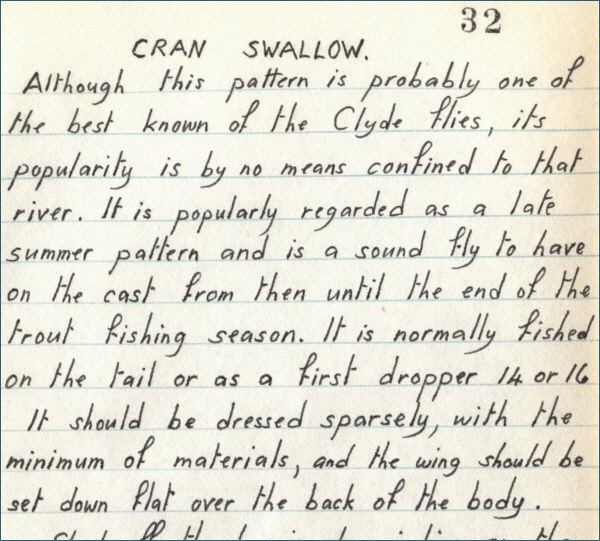
For many of us, though, the term “Scottish trout flies” will bring to mind the many beautiful well known loch fly patterns, for the most part simple flies dressed using the fur and feather of native animals and birds, their origins lost in time but still as effective as ever, taking baskets of trout for those who ply their craft on the Scottish Lochs. Famous flies like the Bloody Butcher, Kingfisher Butcher, Greenwell’s Glory, Alexandra, Grouse and Green, Mallard and Claret, Kate McLaren, Invicta, Peter Ross, Red Palmer, Soldier Palmer, Zulu, Blae and Black, Woodcock and Yellow, Cinnamon and Gold, Wickham’s Fancy, and many more – fished on a cast of three flies over the front of a drifting boat or from the loch shore. Some examples are illustrated below, together with the materials required for their dressing.
Scottish Loch Flies
I list below just a few of the most famous of all our traditional Scottish loch flies, most of them still in regular use today, filling many a fisherman’s basket on Scottish lochs large and small, and further afield too.
Greenwell’s Glory
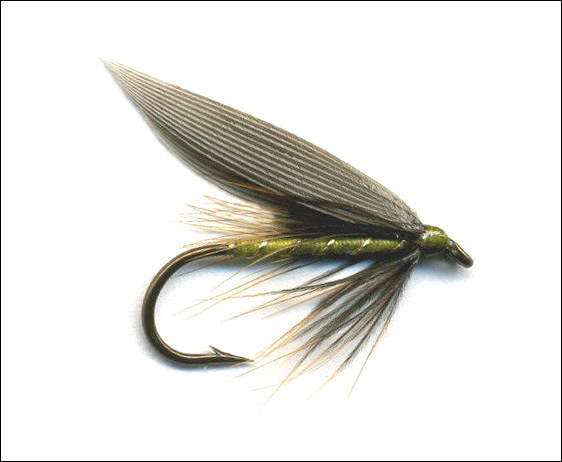
The famous Greenwell’s Glory was tied in 1854 by James Wright, of Sprouston on the River Tweed, at the request of Canon William Greenwell of Durham, and has since become one of the most widely used of all trout flies. Tied either as a wet or dry fly, or adapted as a nymph, it is an excellent representation of an olive.
Hook: 14 to 10
Body: waxed yellow silk
Rib: fine oval gold tinsel
Wing: grey mallard
Hackle: greenwells hen
Mallard and Claret
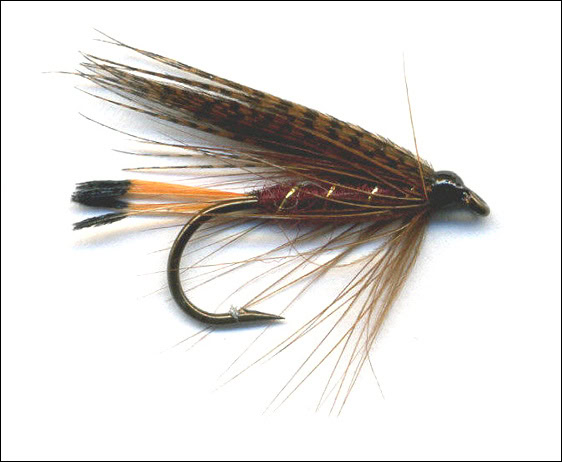
The Mallard and Claret, like its relative, the Grouse and Claret, is a superb general loch fly pattern. Few loch fly boxes will not have a few of both. A favourite as a dropper fly for many loch fishermen here in Scotland. Also very popular for sea trout at night on Scottish rivers. The pattern is said to have been created by William Murdoch of Aberdeen.
Hook: 14 to 10
Tail: golden pheasant tippets
Body: claret wool or seal’s fur
Rib: oval gold tinsel
Wing: bronze mallard (folded)
Hackle: brown or black
Grouse and Green
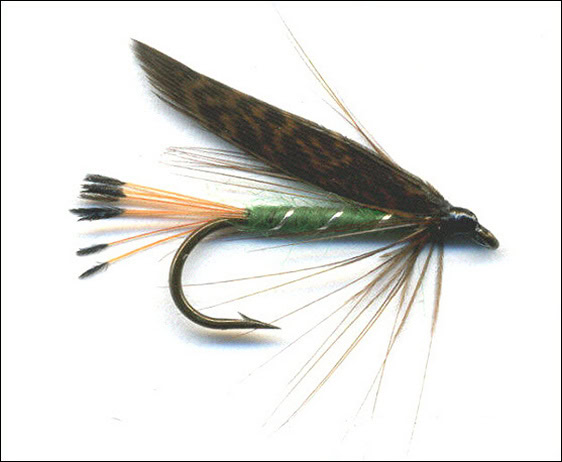
The Grouse and Green is one among a series of patterns dressed with a wing made from the tail feathers of a grouse. Though not as much used as the Grouse and Claret, it is nevertheless a good sedge, or caddis fly, imitation, a good choice for a summer evening on the loch.
Hook: 14 to 10
Tail: golden pheasant tippets
Body: green wool or seal’s fur
Rib: oval silver tinsel
Wing: grouse centre tail
Hackle: brown hen
Woodcock and Yellow
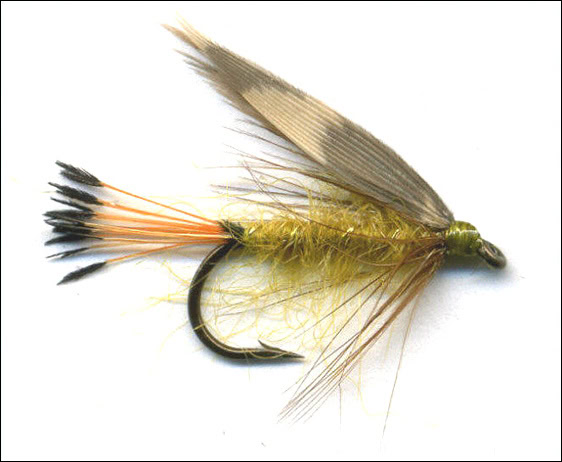
The woodcock and Yellow is probably the best known and most used of the Woodcock trout fly series, a good caddis or sedge representation used by many loch fishermen to good effect on summer evenings. It is also a favourite of many Scottish sea trout fishermen who fish the rivers at night.
Hook: 14 to 10
Tail: golden pheasant tippets
Body: yellow wool or seal’s fur
Rib: oval gold tinsel
Wing: Woodcock
Hackle: brown hen
Blae and Black
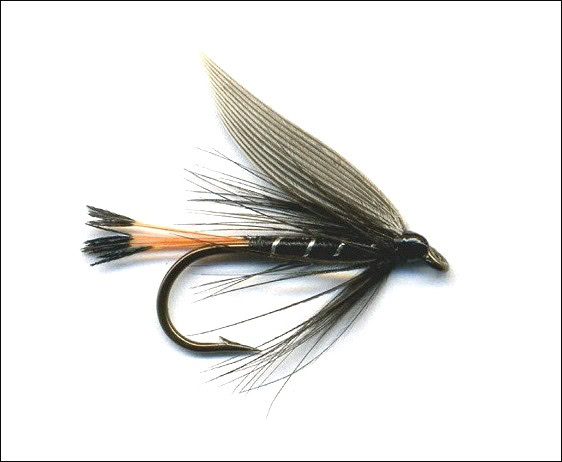
A very old Scottish loch fly, its beginnings unclear, the Blae and Black is likely taken by the trout for a hatching midge. It is at its best fished early in the season as a dropper on a cast of three or four.
Hook: 14 to 10
Tail: golden pheasant tippets
Body: black floss, wool or seal’s fur
Rib: oval silver tinsel
Wing: grey mallard
Hackle: black hen
Peter Ross
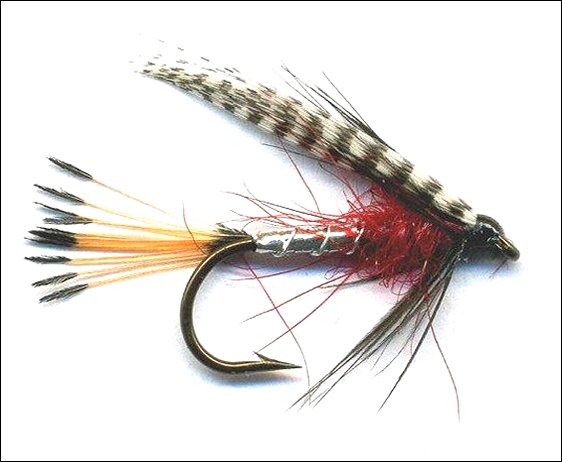
This loch fly is a variant of the Teal and Red, created at the turn of the century by Peter Ross of Killin on the shores of Loch Tay. It is popular among many loch fishers, though others have little luck with it. Possibly taken by the trout for a shrimp or, more likely, a small fish, the Peter Ross is a sound choice as a tail fly.
Hook: 14 to 10
Tail: golden pheasant tippets
Body: silver tinsel/red seals fur
Rib: oval silver tinsel or wire
Wing: teal
Hackle: black hen
Black Pennell
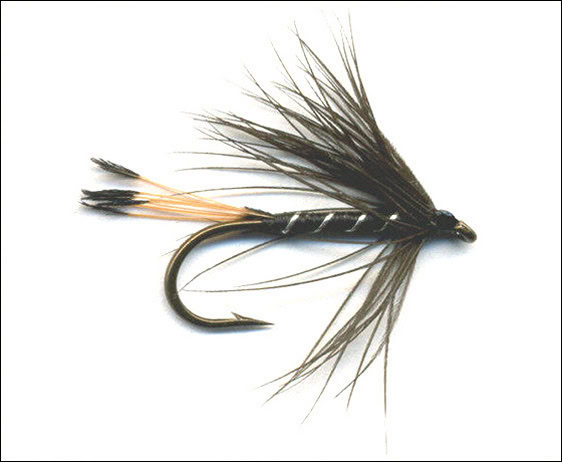
The Black Pennell takes its name from its creator H. Cholmondeley Pennell, who devised it in the nineteenth century. It is popular as a bob fly on highland lochs, particularly effective in early season in a hatch of black midges.
Hook: 14 to 10
Tail: golden pheasant tippets
Body: black floss
Rib: oval silver tinsel
Hackle: black hen
Zulu
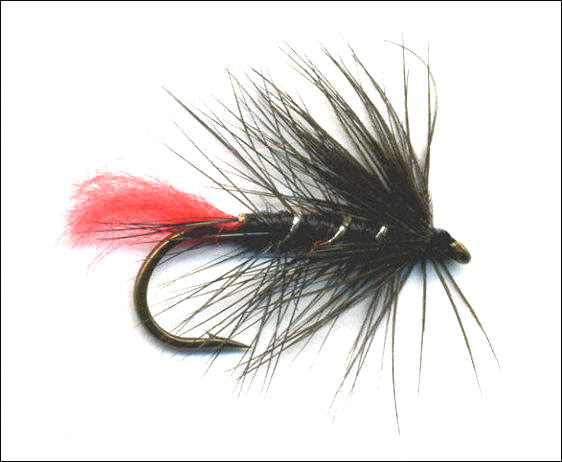
The Black Zulu is said to have been banned from use in fishing competitions because of its effectiveness. It is normally fished as a bob fly, tripped over the top of the waves with a good wind on the loch. The Blue Zulu, which adds a blue hackle at the front, is a favourite variant, almost as effective as the black version.
Hook: 14 to 10
Tail: red wool
Body: black wool or seals fur
Rib: oval silver tinsel or wire
Hackle: black hen palmered
Red Palmer
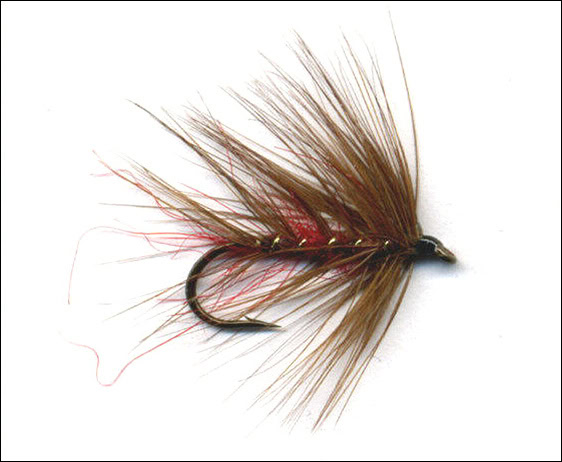
On the remote lochs of the Northern Highlands, there are not many flies which can compete with the Red Palmer as a taker of loch trout, other than maybe the Black Zulu. It is especially effective employed on the bob in a good wave. Probably an even more used variant is the Soldier Palmer, which has a tail of red wool added.
Hook: 14 to 10
Body: red wool or seal’s fur
Rib: oval gold tinsel
Hackle: palmered brown hen
Cinnamon and Gold
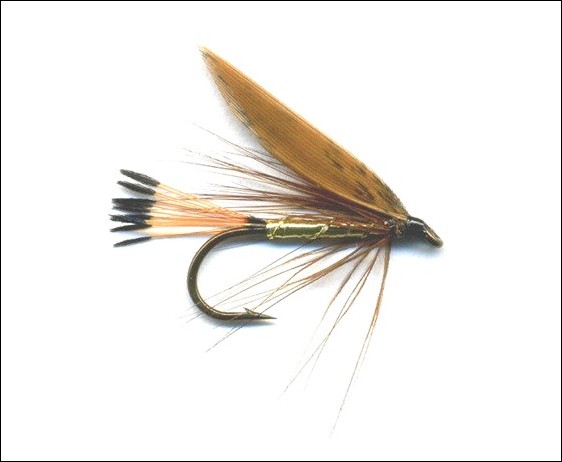
A variant of the old pattern, the Cinnamon fly, the Cinnamon and Gold is effective, particularly in the smaller sizes as a tail fly, an attractor pattern which might be taken for a variety of creatures, perhaps a small fish or maybe a hatching sedge.
Hook: 14 to 10
Tail: golden pheasant tippets
Body: flat gold tinsel
Rib: oval gold tinsel
Wing: speckled hen
Hackle: brown hen
Dunkeld
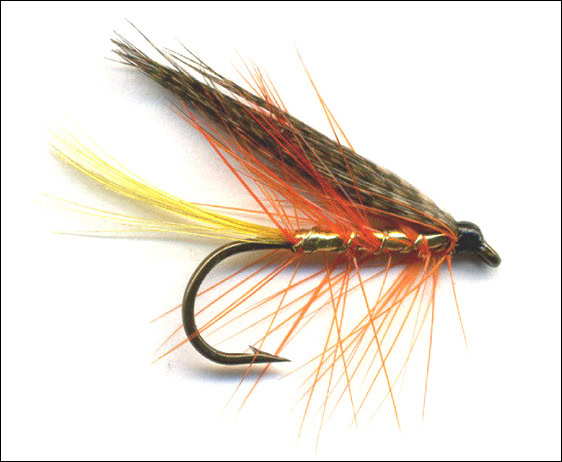
The trout pattern is a cut down or modified version of the Dunkeld salmon fly. Like the Cinnamon and Gold and Kingfisher Butcher, it is a good attractor pattern on most Scottish lochs. It is a great favourite of many fished as a small fish imitation on the tail of a cast. As a sea trout fly for night fishing it is also held in high regard.
Hook: 14 to 10
Tail: golden pheasant crest
Body: flat gold tinsel
Rib: oval gold tinsel
Wing: bronze mallard (folded)
Hackle: orange cock palmered
Jungle cock cheeks may be added
Butcher
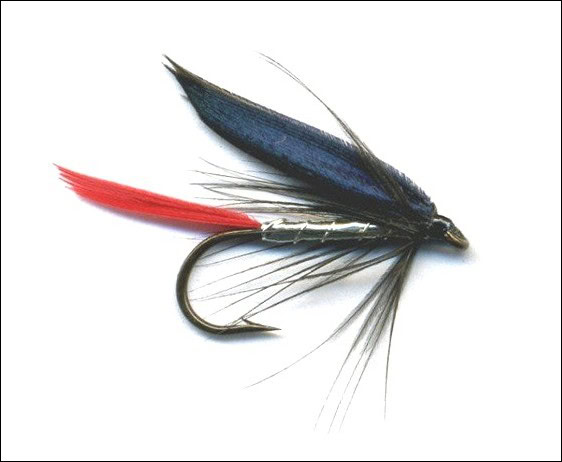
In the view of R. C. Bridgett, “The most deadly loch fly ever invented, dressed with split wings well laid back, used on the bob and made to trip across the waves, it is an exceedingly reliable fly on every loch that I have fished. If winged in the ordinary way it is quite a good tail fly and used by many in this position with considerable effect”. Said to have been created in the early nineteenth century by Messrs Jewhurst and Moon, who were butchers to trade. It was originally known as Moon’s Fly, but was renamed “Butcher”, after its creators rather than for its killing properties on the loch.
Hook: 14 to 10
Tail: red ibis or substitute
Body: silver tinsel
Rib: oval silver tinsel or wire
Wing: mallard blues
Hackle: black hen
For maps and information on some of the best places to fish for wild Scottish brown trout see TROUT FISHING IN SCOTLAND
Trout Dry Flies
In traditional dry fly fishing, as practised throughout the British Isles – from the great loughs of Ireland to the famed chalkstreams of southern England (e.g. Test, Avon, Itchen); from the grand trout rivers of Scotland (e.g. Don, Tummel, Tay, Tweed and Clyde) to the border streams of Wales; from the Scottish Highland lochs to the English North Country streams and becks – and indeed on trout waters the world over, the angler generally sets out to match the hatch , i.e. to present an imitation which resembles, as closely as possible, those flies observed on the water surface and on which the trout appear to be feeding at the time. He will aim to select an artificial fly from his fly box similar, in size, shape and colour, to the insects the trout are taking on the river, or lake, surface. Throughout the fly fishing season the fly angler may expect a large variety of different species of fly to appear on the river, depending on the time of year, the time of day, the state of the river and the prevailing weather conditions and he must be prepared to adapt his approach, and his choice of fly, accordingly. Very early in the season he might expect to see the March Brown ( Rhithrogena germanica ) and he should be prepared to match a hatch with a suitable imitation; the large Dark Olive ( Baetis rhodani ) might make an appearance, particularly around the middle of the day, which he might try to emulate with a Rough Olive dressing or perhaps a Greenwell’s Glory. Later in the season, an appearance of pale wateries ( Baetis fuscatus ) might be matched by a suitable likeness in the form of a Blue Quill or Pale Watery Dun; High summer might see a hatch of the Blue Winged Olive ( Ephemerella ignita ), to be matched with an artificial of that name or perhaps a Pheasant Tail; Medium Olives ( Baetis Tenax ) might be appropriately matched by a Medium Olive Dun or a Gold Ribbed Hare’s Ear; A Blue Dun or Olive Quill might be employed to imitate an Olive Upright ( Rhithrogena semicolorata) , while a Coch y Bonddu might be presented as a beetle imitation; A Black Spider of Black Gnat might be selected to represent a midsummer swarm of Black Gnats (Bibio johannis) ; A Silver, Brown or Cinnamon Sedge imitation might do the job on those long summer evenings on loch or river.
Trout Nymphs
It may not be quite so easy for the fly angler to discern what is going on under the river or lake surface. However, personal experience, a grounding in entomology together with some familiarity with angling tradition, custom and practice, will allow him to make a sound selection of a suitable fly imitation to represent whatever the trout may be feeding on below. Regardless of what the trout are feeding on, a suitable imitation should be found to represent it, to be presented at an appropriate depth and behaving in a way which will deceive the trout into thinking it is real and edible. He might select an imitation of the nymphs of the various upwinged flies (Ephemeroptera) , the olives and mayflies of river and lake; or the Sedge or Caddis fly (Trichoptera) , in various stages of the life cycle, first as cased caddis (sedge larva) and later as the more mobile plump pupa, taken eagerly by the trout as it emerges as an adult sedge; one of the stonefly nymphs (Plecoptera) of the river or the midges or buzzers (Chronomids) of the lake, in their various incarnations of bloodworm or midge larva, free swimming midge pupa or hatching midge; the Corixa of the stillwater shallows or the larger nymph of the Damsel fly (Agrion virgo) or perhaps the tasty looking imitation of a freshwater shrimp.
Trout Lures and Streamers
Lures and streamers, representing either small fish, leech or the larger species of nymph, can vary in size from an inch or so to several inches, depending on the quarry species and the bait the streamer is intended to imitate. For trout fishing, they are normally up to a few inches in length. Widely used for wild trout in North America and other species worldwide, streamers are most commonly used in the UK for rainbow trout fly fishing in stocked fisheries and sometimes for brown trout inriver or lake but may also be used for other predatory species, such as pike, perch or zander in fresh water or for predatory saltwater species such as mackerel, pollack and bass.
Fly Fishing Worldwide
Fly Fishing for Trout and other Fish
Brown trout ( Salmo trutta ) and grayling ( Thymallus thymallus ) were the prime quarry of early fly anglers in Europe and the Brown Trout has since been introduced to all other continents except Antarctica. In more recent times, to the list of fish species now targeted by the fly fisherman worldwide we might add several other trout species such as the Marbled Trout of Slovenia ( Salmo (trutta) marmorata ); the Cutthroat Trout ( Oncorhychus clarki ) of the north western coastal streams North America; the Rainbow Trout ( Oncorhychus mykiss ) of North America, in recent years imported into Europe and bred as both a food and sport fish; the Steelhead, a seagoing migratory form of the rainbow trout; the Golden Trout of California; Several species of Char ( Salvelinus ), including Arctic Char, Dolly Varden, Speckled Char, Lake Trout and Bull Trout; Atlantic salmon ( Salmo salar ) and the various species of Pacific salmon – the main ones being Sockeye ( Oncorhychus nerka ), Chinook or King Salmon ( Oncorhychus tshawytscha ), Chum ( Oncorhychus keta ), Pink ( Oncorhychus gorbuska ) and Coho or Silver Salmon ( Oncorhychus kisutch ); the Huchen of the Danube and the Taimen and Lenok of Asiatic Siberia; Largemouth Bass ( Micropterus salmoides ) and Smallmouth Bass ( Micropterus dololmieui ); European sea trout; saltwater species such as Bass, Bonefish, Tarpon, Permit, Trevally, Tuna, Dorado, Barramundi, Snook and Barracuda; as well as European coarse fish such as pike ( Essox lucius ), perch, chub, dace and carp.
